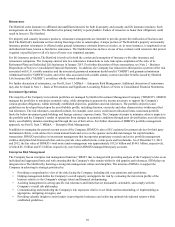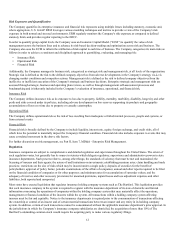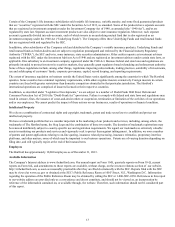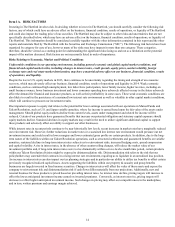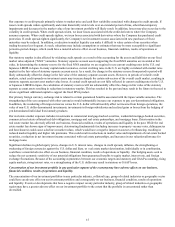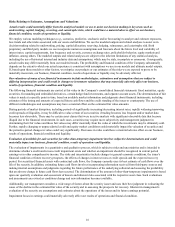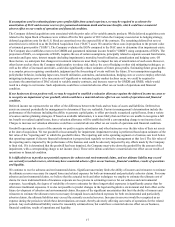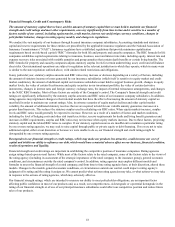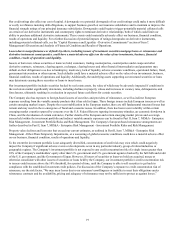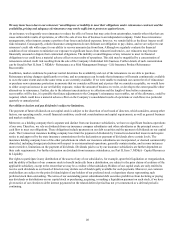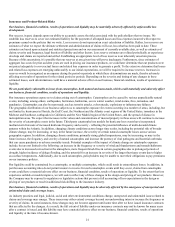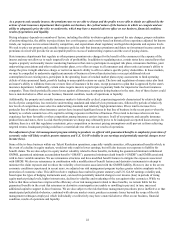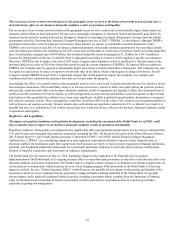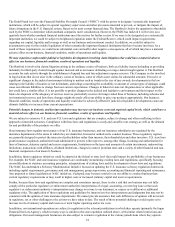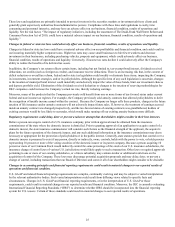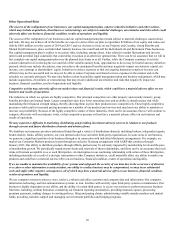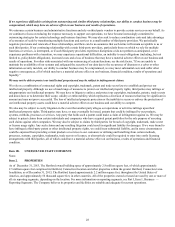The Hartford 2013 Annual Report Download - page 19
Download and view the complete annual report
Please find page 19 of the 2013 The Hartford annual report below. You can navigate through the pages in the report by either clicking on the pages listed below, or by using the keyword search tool below to find specific information within the annual report.19
Our credit ratings also affect our cost of capital. A downgrade or a potential downgrade of our credit ratings could make it more difficult
or costly to refinance maturing debt obligations, to support business growth at our insurance subsidiaries and to maintain or improve the
financial strength ratings of our principal insurance subsidiaries. Downgrades could begin to trigger potentially material collateral calls
on certain of our derivative instruments and counterparty rights to terminate derivative relationships, both of which could limit our
ability to purchase additional derivative instruments. These events could materially adversely affect our business, financial condition,
results of operations and liquidity. For a further discussion of potential impacts of ratings downgrades on derivative instruments,
including potential collateral calls, see the "Capital Resources and Liquidity - Derivative Commitments" section of Item 7.
Management's Discussion and Analysis of Financial Condition and Results of Operations.
Losses due to nonperformance or defaults by others, including issuers of investment securities mortgage loans or reinsurance and
derivative instrument counterparties, could have a material adverse effect on the value of our investments, business, financial
condition, results of operations and liquidity.
Issuers or borrowers whose securities or loans we hold, customers, trading counterparties, counterparties under swaps and other
derivative contracts, reinsurers, clearing agents, exchanges, clearing houses and other financial intermediaries and guarantors may
default on their obligations to us due to bankruptcy, insolvency, lack of liquidity, adverse economic conditions, operational failure, fraud,
government intervention or other reasons. Such defaults could have a material adverse effect on the value of our investments, business,
financial condition, results of operations and liquidity. Additionally, the underlying assets supporting our structured securities or loans
may deteriorate causing these securities or loans to incur losses.
Our investment portfolio includes securities backed by real estate assets, the value of which may be adversely impacted if conditions in
the real estate market significantly deteriorate, including declines in property values and increases in vacancy rates, delinquencies and
foreclosures, ultimately resulting in a reduction in expected future cash flows for certain securities.
The Company also has exposure to foreign-based issuers of securities and providers of reinsurance, as well as indirect European
exposure resulting from the variable annuity products that it has sold in Japan. These foreign issuers include European issuers as well as
certain emerging market issuers. Despite the recent stabilization in the European market, there are still fundamental structural issues that
remain and may result in the re-emergence of fiscal and economic issues. In addition, there has been recent volatility within certain
emerging market countries spurred by concerns over the U.S. Federal Reserve tapering its monetary stimulus, an economic slowdown in
China, and the devaluation of certain currencies. Further details of the European and certain emerging market private and sovereign
issuers held within the investment portfolio and indirect variable annuity exposures can be found in Part II, Item 7, MD&A - Enterprise
Risk Management - Investment Portfolio Risks and Risk Management. The Company's European based reinsurance arrangements are
further described in Part II, Item 7, MD&A - Enterprise Risk Management - Investment Portfolio Risks and Risk Management.
Property value declines and loss rates that exceed our current estimates, as outlined in Part II, Item 7, MD&A - Enterprise Risk
Management - Other-Than-Temporary Impairments, or a worsening of global economic conditions could have a material adverse effect
on our business, financial condition, results of operations and liquidity.
To the extent the investment portfolio is not adequately diversified, concentrations of credit risk may exist which could negatively
impact the Company if significant adverse events or developments occur in any particular industry, group of related industries or
geographic regions. The Company’s investment portfolio is not exposed to any credit concentration risk of a single issuer greater than
10% of the Company's stockholders' equity other than U.S. government and U.S. government agencies backed by the full faith and credit
of the U.S. government, and the Government of Japan. However, if issuers of securities or loans we hold are acquired, merge or
otherwise consolidate with other issuers of securities or loans held by the Company, our investment portfolio’s credit concentration risk
to issuers could increase above the 10% threshold, for a period of time, until the Company is able to sell securities to get back in
compliance with the established investment credit policies. For discussion of the Company’s exposure to credit concentration risk of
reinsurers, see the risk factor, “We may incur losses due to our reinsurers' unwillingness or inability to meet their obligations under
reinsurance contracts and the availability, pricing and adequacy of reinsurance may not be sufficient to protect us against losses.”



